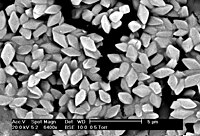
Intermittent induction of LEA peptide by lactose enhances the expression of insecticidal proteins in Bacillus thuringiensis
Sign Up to like & getrecommendations! Published in 2022 at "FEBS Open Bio"
DOI: 10.1002/2211-5463.13448
Abstract: Cry toxins from Bacillus thuringiensis (Bt) have been extensively applied in agriculture to substitute the use of chemical insecticides. We have previously reported the use of a coexpression system in which late embryogenesis abundant (LEA)… read more here.
Keywords: bacillus thuringiensis; lea; expression; intermittent induction ... See more keywords

Optimization of feather degradation by a Bacillus thuringiensis isolate using response surface methodology and investigation of the feather protein hydrolysate structure.
Sign Up to like & getrecommendations! Published in 2022 at "Biotechnology and applied biochemistry"
DOI: 10.1002/bab.2436
Abstract: Valorization of chicken feather is a long-sought approach for its sustainable disposal. Being protein rich, hydrolyzed chicken feather has a wide range of applications, not limited to formulation of microbiological culture media, animal feed, and… read more here.
Keywords: bacillus thuringiensis; response surface; feather degradation; methodology ... See more keywords

Characterization of field-evolved resistance to Bacillus thuringiensis-derived Cry1F δ-endotoxin in Spodoptera frugiperda populations from Argentina.
Sign Up to like & getrecommendations! Published in 2018 at "Pest management science"
DOI: 10.1002/ps.4776
Abstract: BACKGROUND Transgenic maize (Zea mays L.) event TC1507 (Herculex® I insect protection), expressing Cry1F δ-endotoxin derived from Bacillus thuringiensis var. aizawai, was commercialized in 2003 in the Americas. Spodoptera frugiperda (J.E. Smith) (Lepidoptera: Noctuidae) susceptibility… read more here.
Keywords: spodoptera frugiperda; resistance; cry1f endotoxin; frugiperda ... See more keywords

Two ABC transporters are differentially involved in the toxicity of two Bacillus thuringiensis Cry1 toxins to the invasive crop-pest Spodoptera frugiperda (J. E. Smith).
Sign Up to like & getrecommendations! Published in 2020 at "Pest management science"
DOI: 10.1002/ps.6170
Abstract: BACKGROUND The fall armyworm Spodoptera frugiperda is a major agricultural pest that has invaded the East Hemisphere since 2016, generating a serious threat to the food security worldwide including Africa and Asia. The Cry toxins… read more here.
Keywords: abc transporters; spodoptera frugiperda; sfabcc2 sfabcc3; sfabcc2 ... See more keywords

ZnO nanoparticles produced in the culture supernatant of Bacillus thuringiensis ser. israelensis affect the demographic parameters of Musca domestica using the age-stage, two-sex life table.
Sign Up to like & getrecommendations! Published in 2022 at "Pest management science"
DOI: 10.1002/ps.6783
Abstract: BACKGROUND Indiscriminate use of broad-spectrum insecticides can have deleterious effects on insects and the environment. The use of nanoparticles synthesized from microbes has recently gained importance as a safe alternative to conventional insecticides. Recently, zinc… read more here.
Keywords: zno nanoparticles; supernatant; bacillus thuringiensis; age ... See more keywords

Сitrobacter freundii, a natural associate of the Colorado potato beetle, increases larval susceptibility to Bacillus thuringiensis.
Sign Up to like & getrecommendations! Published in 2022 at "Pest management science"
DOI: 10.1002/ps.6856
Abstract: We assume that certain representatives of gut microflora mediate immune changes during dysbiosis, accelerating septicemia caused by Bacillus thuringiensis. Co-introduction of Citrobacter freundii with Bacillus thuringiensis var. tenebrionis (morrisoni) (Bt) led to an increase in… read more here.
Keywords: colorado potato; bacillus thuringiensis; potato beetle; thuringiensis ... See more keywords

Utilization of a strong promoter combined with the knockout of protease genes to improve the yield of Vip3Aa in Bacillus thuringiensis BMB171.
Sign Up to like & getrecommendations! Published in 2023 at "Pest management science"
DOI: 10.1002/ps.7343
Abstract: BACKGROUND Vip3Aa is an insecticidal protein secreted by some Bacillus thuringiensis strains during vegetative growth. It has excellent insecticidal activity, its mechanism of action is different from that of Cry protein, and it can delay… read more here.
Keywords: bacillus thuringiensis; protease genes; thuringiensis; vip3aa ... See more keywords

Bacillus thuringiensis as a biofertilizer in crops and their implications in the control of phytopathogens and insect pests.
Sign Up to like & getrecommendations! Published in 2023 at "Pest management science"
DOI: 10.1002/ps.7560
Abstract: BACKGROUND Bacillus thuringiensis (Bt) is a spore-forming bacterium that produces insecticidal proteins and other virulence factors and is considered one of the most successful bioinsecticides available to control pests in agriculture. Currently, some Bt strains… read more here.
Keywords: bacillus thuringiensis; control; thuringiensis biofertilizer; crops implications ... See more keywords

Effects of Site-Mutations Within the 22 kDa No-Core Fragment of the Vip3Aa11 Insecticidal Toxin of Bacillus thuringiensis
Sign Up to like & getrecommendations! Published in 2017 at "Current Microbiology"
DOI: 10.1007/s00284-017-1233-y
Abstract: Bacillus thuringiensis vegetative insecticidal proteins (VIPs) are not homologous to other known Cry proteins, and they act against lepidopteran larvae via a unique process. All reported studies on the mode of action of Vip3 proteins… read more here.
Keywords: protein; core fragment; insecticidal; vip3aa11 ... See more keywords

Bacillus thuringiensis as a Biofertilizer and Biostimulator: a Mini-Review of the Little-Known Plant Growth-Promoting Properties of Bt
Sign Up to like & getrecommendations! Published in 2019 at "Current Microbiology"
DOI: 10.1007/s00284-019-01705-9
Abstract: Bacillus thuringiensis (Bt) is a gram-positive spore-forming soil microorganism. Because the insecticidal activities of Bt are well known, it has been used as a tool for insect pest control worldwide. The beneficial features of Bt… read more here.
Keywords: plant growth; bacillus thuringiensis; growth promoting; plant ... See more keywords

In Vitro Cytotoxicity of Parasporins from Native Algerian Bacillus thuringiensis Strains Against Laryngeal and Alveolar Cancers
Sign Up to like & getrecommendations! Published in 2019 at "Current Microbiology"
DOI: 10.1007/s00284-019-01841-2
Abstract: Parasporins (PS), a class of non-insecticidal and non-hemolytic crystal proteins of Bacillus thuringiensis (Bt), are being explored as promising anti-cancer agents due to their specific toxicity to cancer cells. This work is considered as a… read more here.
Keywords: non hemolytic; vitro cytotoxicity; cancer; cytotoxicity ... See more keywords